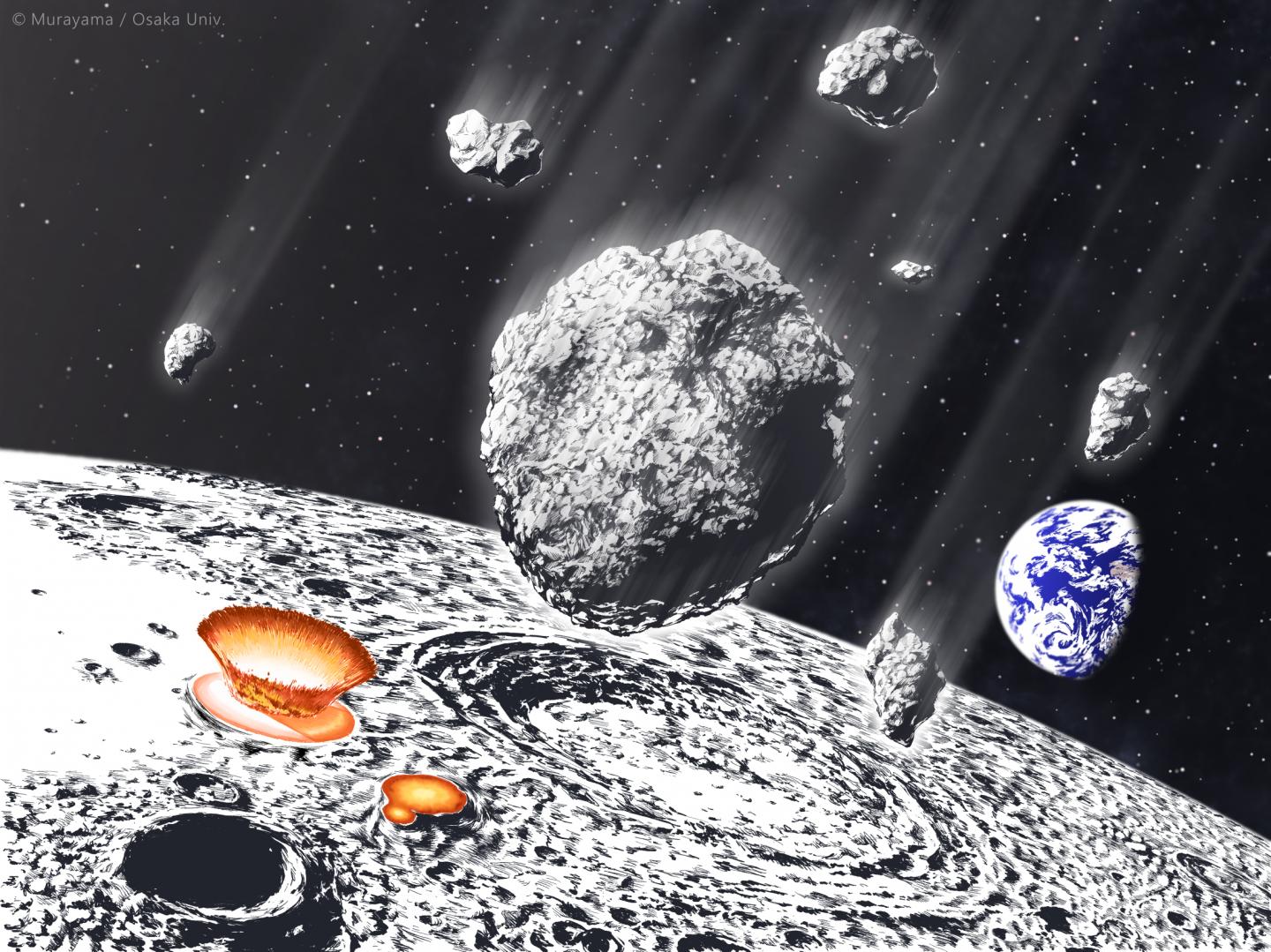Asteroid shower rained space rocks on Earth and the moon 800 million years ago
An asteroid shower thought to have struck the moon and Earth 800 million years ago may have helped trigger Earth's greatest ice ages, a new study finds.
There are many signs that cosmic impacts have had major effects on Earth's history. For example, an asteroid about 6 miles (10 kilometers) wide that hit Earth about 66 million years ago (near what is now the town of Chicxulub (CHEEK-sheh-loob) in Mexico) destroying three-quarters of the animal and plant species on Earth (including most dinosaurs) and leaving behind a gargantuan crater more than 110 miles (180 km) wide.
An asteroid of that size is thought to be capable of striking Earth only once every 100 million years. However, erosion, volcanism and other geologic activity have largely erased any impact craters on Earth made before 600 million years ago, obscuring our knowledge of these cosmic collisions.
Related: Asteroid impact, not volcanic activity, killed the dinosaurs, study finds
In a new study from Japan, to learn more about ancient impacts on Earth, scientists investigated the moon, since craters are preserved well in the vacuum of space on the lunar surface. They investigated 59 lunar craters, each about 12 miles (20 km) wide or larger using the Japanese lunar orbiter spacecraft Kaguya.
The researchers analyzed when these craters formed by examining the rings of rock ejected from the impacts which created them. Small meteoroids rain down on the moon at a predictable rate, leaving behind craters ranging from 330 to 3,300 feet (100 to 1,000 meters) wide, and by counting the number of these small craters in the ejecta of the large craters, they could estimate when the large craters formed.
The scientists found that eight of the large craters they studied formed simultaneously, including the Copernicus crater which is 57 miles (93 km) wide, from which Apollo astronauts collected samples. Using radioisotope dating of ejected material from Copernicus and glassy beads formed by meteorite impacts gathered from a number of Apollo landing sites, the researchers estimated these craters were born in the wake of an asteroid shower about 800 million years ago.
Breaking space news, the latest updates on rocket launches, skywatching events and more!
Assuming that an asteroid shower that bombarded the moon would have also impacted Earth, the scientists calculated that 40 trillion to 50 trillion metric tons worth of meteoroids would have hit our planet in this shower, 30 to 60 times the mass of the Chicxulub dinosaur-killer.
These cosmic impacts would have struck Earth and the moon immediately before the Cryogenian period 635 million to 720 million years ago. During the Cryogenian period, Earth saw its greatest ice ages, which potentially covered the entire planet in ice, as well as the oldest animal fossils (which are sponges.)
Previous research suggested that the Chicxulub impact blasted up an enormous amount of dust, which darkened the skies and cooled Earth, study lead author Kentaro Terada, a cosmochemist at Osaka University in Japan, told Space.com. Moreover, a meteoroid shower 470 million years ago may have also kicked up extraordinary amounts of dust, potentially triggering the so-called mid-Ordovician ice age, he added.
"From these considerations, I can say that it is not strange that an asteroid shower 800 million years ago might have triggered an ice age, because the total mass 800 million years ago in our study is 10 to 100 times larger than that of the Chicxulub impact and a meteoroid shower 470 million years ago," Terada said.
The researchers estimated this asteroid shower would have scattered 100 billion metric tons of phosphorus across Earth, which is about 10 times more than the total phosphorus in current day oceans. They suggested this phosphorus may have had untold biological effects — phosphorus is a key element of DNA and cell membranes.
Given the timing of the asteroid shower, Terada and his colleagues suggested it originated from the disruptive event that gave rise to the Eulalia family of asteroids, which formed about 830 million years ago. Prior work suggested the Eulalia family is the parent body of the near-Earth asteroids Bennu and Ryugu. NASA's OSIRIS-REx mission is scheduled to collect samples from Bennu, while Japan's Hayabusa2 probe has collected samples from Ryugu and is scheduled to return to Earth in December.
"My next research plan is to date the collected samples from asteroids Ryugu and Bennu," Terada said. "If we get the age of 800 million years from the Ryugu sample, I will be so excited," he added, as that might support a link between these asteroids and the cosmic impacts they suggest hit Earth and the moon.
The scientists detailed their findings online July 21 in the journal Nature Communications.
Follow Charles Q. Choi on Twitter @cqchoi. Follow us on Twitter @Spacedotcom and on Facebook.

Charles Q. Choi is a contributing writer for Space.com and Live Science. He covers all things human origins and astronomy as well as physics, animals and general science topics. Charles has a Master of Arts degree from the University of Missouri-Columbia, School of Journalism and a Bachelor of Arts degree from the University of South Florida. Charles has visited every continent on Earth, drinking rancid yak butter tea in Lhasa, snorkeling with sea lions in the Galapagos and even climbing an iceberg in Antarctica. Visit him at http://www.sciwriter.us

